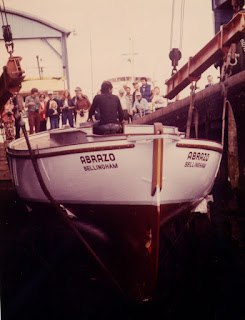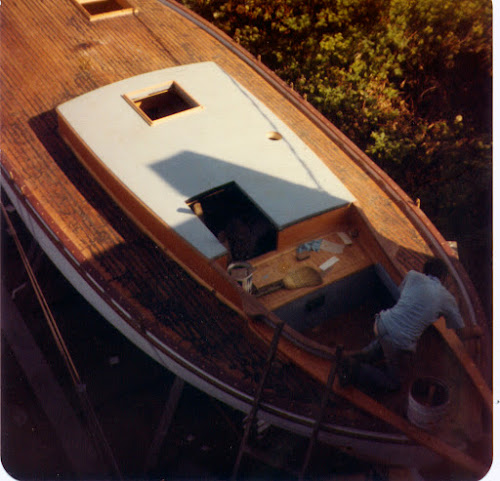Early, early in the morning: I barely had my eyes open when Peter Fromm, our favorite photographer, arrived to document Abrazo’s Launch Day. No floorboards yet, so I’m kneeling on the floor timbers in the galley area. As I recall, my task was to make sure there was no sawdust or other detritus in the bilge.
Who Knew How Much Water Would Seep In When this New Hull
Settled in the Briney?
You can see our cast iron wood stove installed on the
platform to my right. That bar parallel
to the upper surface of the wood stove is one of the stove’s sea rails. The wooden box below the stove will
eventually hold a stainless-steel drawer for firewood (or for potatoes or
whatever you want to store).
Between the wood stove and my head, you see the heat-exchanger
with intake and output hoses for the engine.
(We’re pretty sure we did not fire off that engine until days after the
boat was launched.)
The horizontal counter behind me has a curved edge (above my
left shoulder) that goes under the bridge deck.
This will eventually become the aft galley counter. In the meantime, it serves as a shelf for
tools, and most importantly, as a place to step down from the companionway, or
climb out of the companionway … until Richard builds the companionway
ladder.
Above that counter you see the plywood wall that marks the
back of the galley, along with the electrical panel (black area above my left
shoulder). This is part of the module
that fits over top of the engine.
To my left you see the as-yet-untrimmed bulkhead separating the main cabin settee forward, from the navigation station aft. Like the galley, the nav station is yet to be.
Again looking aft, you see the two bulkheads that mark the aft end of the main cabin. No trim yet. Probably not enough paint, yet, either.
You see the battery switch … that black body just to the
left of my left hand. Black cables
leading left from the switch are the battery cables to the engine.
The black tube in the light below the battery switch is the
portside cockpit scupper. Behind that
tube, in the light shining into the engine room, you see the hanging knee that
supports the port side of the cockpit.
Above the nav station area to my left you can see the
portside hanging knees that support the side deck, outboard of the cabin. We don’t know what that greyish wood piece
that crosses the bulkhead is. Walnut
trim for a bulkhead?
Fastened into the corner of the cabin to my left you see a
vertical copper tube. This is the vent
for the port-side saddle tank beside the cockpit, a tank that will hold
fuel. (There’s another saddle tank on
the starboard side of the cockpit to hold water.)
That black cord dropping from the companionway is electric
power for the light bulbs. Hung in the
cabin, those bulbs reflect on the newly-varnished cabin sides, cabin-top beams,
and tongue-in-groove cabin-top planks.
What a bright spot! In fact, what appear
to be dark lines perpendicular to the deck beams above my head, are shadows and
reflections of the fore-to-aft tongue-in-groove cabin-top planks.
Peter Fromm finally got permission to climb onto the building balcony to photograph Abrazo’s minimal deck hardware: a cleat and a chock in the stern, for tie-up lines:
Then the experts from Seattle arrived: the consummate pros of Associated Boat Movers took over the action.
First, they installed their own supports …
... then they put their special roller skate under the forward edge of Abrazo’s keel:
They backed their special truck under that keel …
And here is the Boat Builder.
Is he tightening a bolt at this last minute?
Peter Fromm immortalized the beautiful propeller.
And then it was time to move …The exit driveway was a bit narrow, what with that rockery of strawberry plants having encroached. Move those logs out of the way, sir. Abrazo is bound for Squalicum Harbor!
Having made the right angle turns from the driveway on to Cornwall, then on to Chestnut St …
… it was a short mile to the Weldcraft yard at Squalicum Harbor …
… where the Seattle pros backed their truck under the Weldcraft tammy lift …
As the lift operator moved toward the water, we were both a little anxious.
“Speed, bonny boat, like a bird on the wing, over the waves to Skye …”
The man in the wheelchair is Hank Baila, Richard’s
father. Blind in one eye after a stroke
at age 48, he’s 64 here, weakened by coronary heart disease. His loving companion Lura Lu Radford stands
behind him.
We didn’t have a master of ceremonies, or any kind of
protocol to follow. All we had to go by
was Bill Modrell’s strong suggestion that we have a piper play “The Skye Boat
Song,” which turns out to be a beautiful piece of music.
OMG: Did anybody pay
the piper that day?
My first effort to christen that boat …
Richard jumped down onto the rocks, retrieved the champagne bottle, and wrapped his arms and hands around mine for the christening.
We smashed that heavy bottle on Abrazo’s bow, and every
photographer in attendance snapped the action!
Stephanie Slade, Marianne Di Angelo, Peter Fromm, and Jan (JP) Mayo …
My buddy Ernie Limbacher told me later that I was not alone in failing with that first blow.
Mamie
Eisenhower had had the same difficulty, bouncing the bottle off the bow when she first tried to christen a
boat.
Time to lower that boat into the water …
Did anyone have any doubts?
Richard thinks he remembers that we rented the Squalicum Boat House for a gathering, but neither of us has any memory except that way too much champagne was consumed before nightfall. We do remember the hangovers.
There must have been some pumping of the bilge, but the planking seams swelled tight quickly.
The next day a fisherman friend towed Abrazo to the commercial side of the harbor and her new moorage.
We moved aboard before September 1, sleeping on top of the tanks in the main cabin, washing dishes in a bucket, doing our best to keep the sawdust out of the granola … and moving forward with construction of the interior.
Hank and Lura Lu probably stayed for a glass of champagne on Launch Day. They soon headed back to Seattle, but not before Hank, proud Papa Dad, posed for this portrait by Peter Fromm.
Hank’s heart disease took him for good on October 30, 1981 … just two months after Abrazo’s launching. So glad he came to see the boat’s progress that day, I am forever grateful to him for the fine, strong, intelligent upraising he gave his son Richard.

























































